
Bath is a city and unparished area in the Bath and North East Somerset unitary area in the ceremonial county of Somerset, England, known for and named after its Roman-built baths. At the 2021 Census, the population was 101,557. Bath is in the valley of the River Avon, 97 miles (156 km) west of London and 11 miles (18 km) southeast of Bristol. The city became a World Heritage Site in 1987, and was later added to the transnational World Heritage Site known as the "Great Spa Towns of Europe" in 2021. Bath is also the largest city and settlement in Somerset.

A bathroom or washroom is a room, typically in a home or other residential building, that contains either a bathtub or a shower. The inclusion of a wash basin is common. In some parts of the world e.g. India, a toilet is typically included in the bathroom; in others, the toilet is typically given a dedicated room separate from the one allocated for personal hygiene activities. In the United States, the word 'bathroom' is often used to refer to any room that contains a toilet, regardless of the inclusion of a bath or shower.

In ancient Rome, thermae and balneae were facilities for bathing. Thermae usually refers to the large imperial bath complexes, while balneae were smaller-scale facilities, public or private, that existed in great numbers throughout Rome.

The Roman Baths are well-preserved thermae in the city of Bath, Somerset, England. A temple was constructed on the site between 60 and 70 AD in the first few decades of Roman Britain. Its presence led to the development of the small Roman urban settlement known as Aquae Sulis around the site. The Roman baths—designed for public bathing—were used until the end of Roman rule in Britain in the 5th century AD. According to the Anglo-Saxon Chronicle, the original Roman baths were in ruins a century later. The area around the natural springs was redeveloped several times during the Early and Late Middle Ages.

Bathing is the act of washing the body, usually with water, or the immersion of the body in water. It may be practiced for personal hygiene, religious ritual or therapeutic purposes. By analogy, especially as a recreational activity, the term is also applied to sun bathing and sea bathing.

Thermae Bath Spa is a combination of the historic spa and a contemporary building in the city of Bath, England, and reopened in 2006. Bath and North East Somerset council own the buildings, and, as decreed in a Royal Charter of 1590, are the guardians of the spring waters, which are the only naturally hot, mineral-rich waters in the UK. The Spa is operated by YTL Hotels.
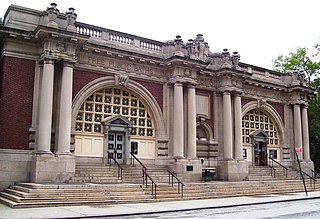
Public baths originated when most people in population centers did not have access to private bathing facilities. Though termed "public", they have often been restricted according to gender, religious affiliation, personal membership, and other criteria. In addition to their hygienic function, public baths have also been social meeting places. They have included saunas, massages, and other relaxation therapies, as are found in contemporary day spas. As the percentage of dwellings containing private bathrooms has increased in some societies, the need for public baths has diminished, and they are now almost exclusively used recreationally.

A spa is a location where mineral-rich spring water is used to give medicinal baths. Spa towns or spa resorts typically offer various health treatments, which are also known as balneotherapy. The belief in the curative powers of mineral waters goes back to prehistoric times. Such practices have been popular worldwide, but are especially widespread in Europe and Japan. Day spas and medspas are also quite popular, and offer various personal care treatments.

A frigidarium is one of the three main bath chambers of a Roman bath or thermae, namely the cold room. It often contains a swimming pool.

The Baths of Agrippa was a structure of ancient Rome, Italy, built by Marcus Vipsanius Agrippa. It was the first of the great thermae constructed in the city, and also the first public bath.
Thomas Baldwin was an English architect in the city of Bath, who was responsible for designing some of Bath's principal Georgian buildings.
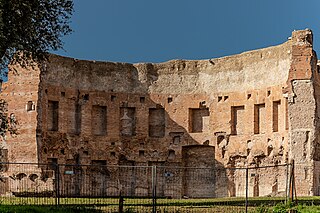
Bathing played a major part in ancient Roman culture and society. It was one of the most common daily activities and was practised across a wide variety of social classes. Though many contemporary cultures see bathing as a very private activity conducted in the home, bathing in Rome was a communal activity. While the extremely wealthy could afford bathing facilities in their homes, private baths were very uncommon, and most people bathed in the communal baths (thermae). In some ways, these resembled modern-day destination spas as there were facilities for a variety of activities from exercising to sunbathing to swimming and massage.

A steam bath is a steam-filled room for the purpose of relaxation and cleansing. It has a long history, going back to Greek and Roman times.
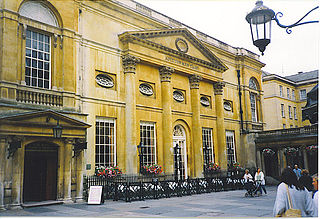
The Grand Pump Room is a historic building in the Abbey Churchyard, Bath, Somerset, England. It is adjacent to the Roman Baths and is named for water that is pumped into the room from the baths' hot springs. Visitors can drink the water or have other refreshments while there.
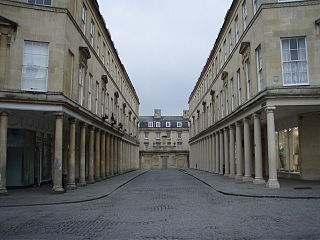
Bath Street in Bath, Somerset, England was built by Thomas Baldwin in 1791. Several of the buildings have been designated as Grade I listed buildings.

Cleveland Pools located in Hampton Row, Bath, Somerset, England is a semi-circular lido built to designs by John Pinch the Elder in 1815. It is believed to be the oldest public outdoor swimming pool in the UK. It is a Grade II* listed building.
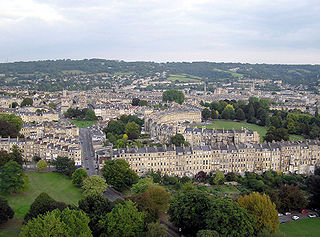
The buildings and architecture of Bath, a city in Somerset in the south west of England, reveal significant examples of the architecture of England, from the Roman Baths, to the present day. The city became a World Heritage Site in 1987, largely because of its architectural history and the way in which the city landscape draws together public and private buildings and spaces. The many examples of Palladian architecture are purposefully integrated with the urban spaces to provide "picturesque aestheticism". In 2021, the city was added to a second World Heritage Site, a group of historic spa towns across Europe known as the "Great Spas of Europe". Bath is the only entire city in Britain to achieve World Heritage status, and is a popular tourist destination.

The following is a timeline of the history of the city of Bath, Somerset, England.
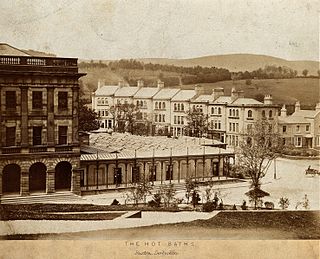
The Buxton Baths using natural thermal spring water are in Buxton, Derbyshire, England. The baths date back to Roman times and were the basis for developing Buxton as a Georgian and Victorian spa town. The present buildings of the Thermal Baths and the Natural Mineral Baths were opened in the 1850s. They are positioned either side of the Buxton Crescent at the foot of The Slopes in the town's Central Conservation Area. They are both Grade II listed buildings designed by Henry Currey, architect for the 7th Duke of Devonshire.


















